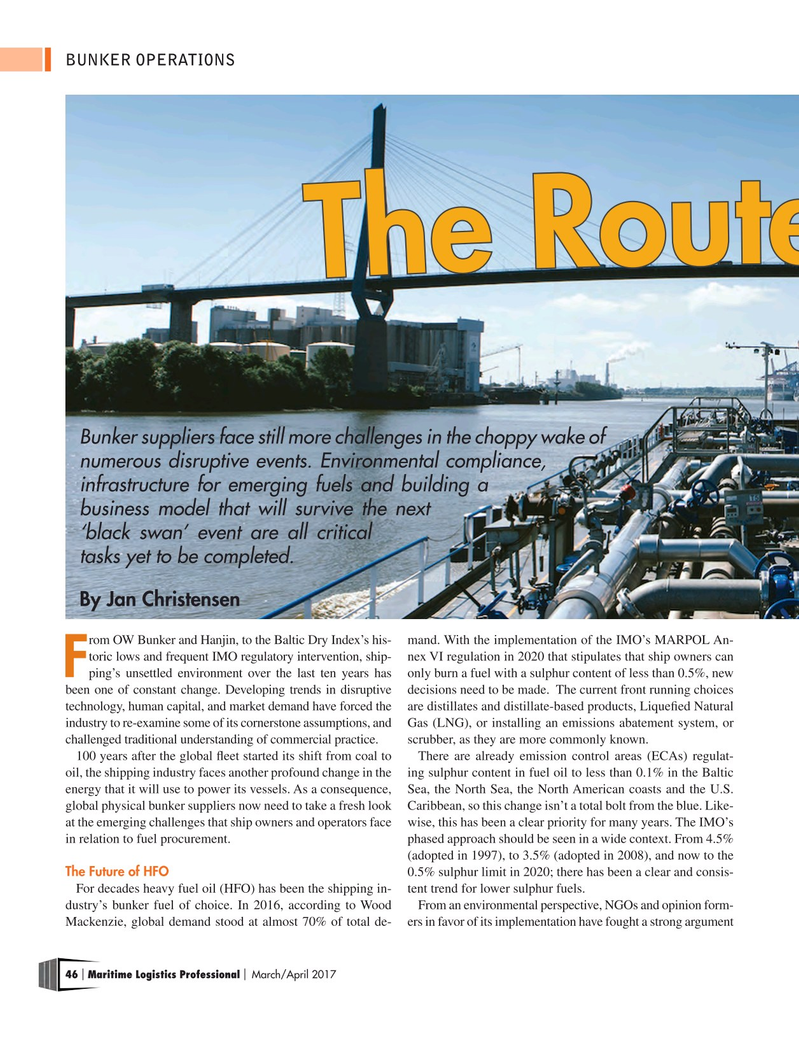
Page 46: of Maritime Logistics Professional Magazine (May/Jun 2017)
BUNKER OPERATIONS & PORTS
Read this page in Pdf, Flash or Html5 edition of May/Jun 2017 Maritime Logistics Professional Magazine
BUNKER OPERATIONS t o e t u 2 o 0
R 2 e 0 h
T
Bunker suppliers face still more challenges in the choppy wake of numerous disruptive events. Environmental compliance, infrastructure for emerging fuels and building a business model that will survive the next ‘black swan’ event are all critical tasks yet to be completed.
By Jan Christensen rom OW Bunker and Hanjin, to the Baltic Dry Index’s his- mand. With the implementation of the IMO’s MARPOL An- toric lows and frequent IMO regulatory intervention, ship- nex VI regulation in 2020 that stipulates that ship owners can
Fping’s unsettled environment over the last ten years has only burn a fuel with a sulphur content of less than 0.5%, new been one of constant change. Developing trends in disruptive decisions need to be made. The current front running choices technology, human capital, and market demand have forced the are distillates and distillate-based products, Liquefed Natural industry to re-examine some of its cornerstone assumptions, and Gas (LNG), or installing an emissions abatement system, or challenged traditional understanding of commercial practice. scrubber, as they are more commonly known.
100 years after the global feet started its shift from coal to There are already emission control areas (ECAs) regulat- oil, the shipping industry faces another profound change in the ing sulphur content in fuel oil to less than 0.1% in the Baltic energy that it will use to power its vessels. As a consequence, Sea, the North Sea, the North American coasts and the U.S. global physical bunker suppliers now need to take a fresh look Caribbean, so this change isn’t a total bolt from the blue. Like- at the emerging challenges that ship owners and operators face wise, this has been a clear priority for many years. The IMO’s in relation to fuel procurement. phased approach should be seen in a wide context. From 4.5% (adopted in 1997), to 3.5% (adopted in 2008), and now to the
The Future of HFO 0.5% sulphur limit in 2020; there has been a clear and consis-
For decades heavy fuel oil (HFO) has been the shipping in- tent trend for lower sulphur fuels.
dustry’s bunker fuel of choice. In 2016, according to Wood From an environmental perspective, NGOs and opinion form-
Mackenzie, global demand stood at almost 70% of total de- ers in favor of its implementation have fought a strong argument 46 Maritime Logistics Professional March/April 2017 | |

 45
45

 47
47
